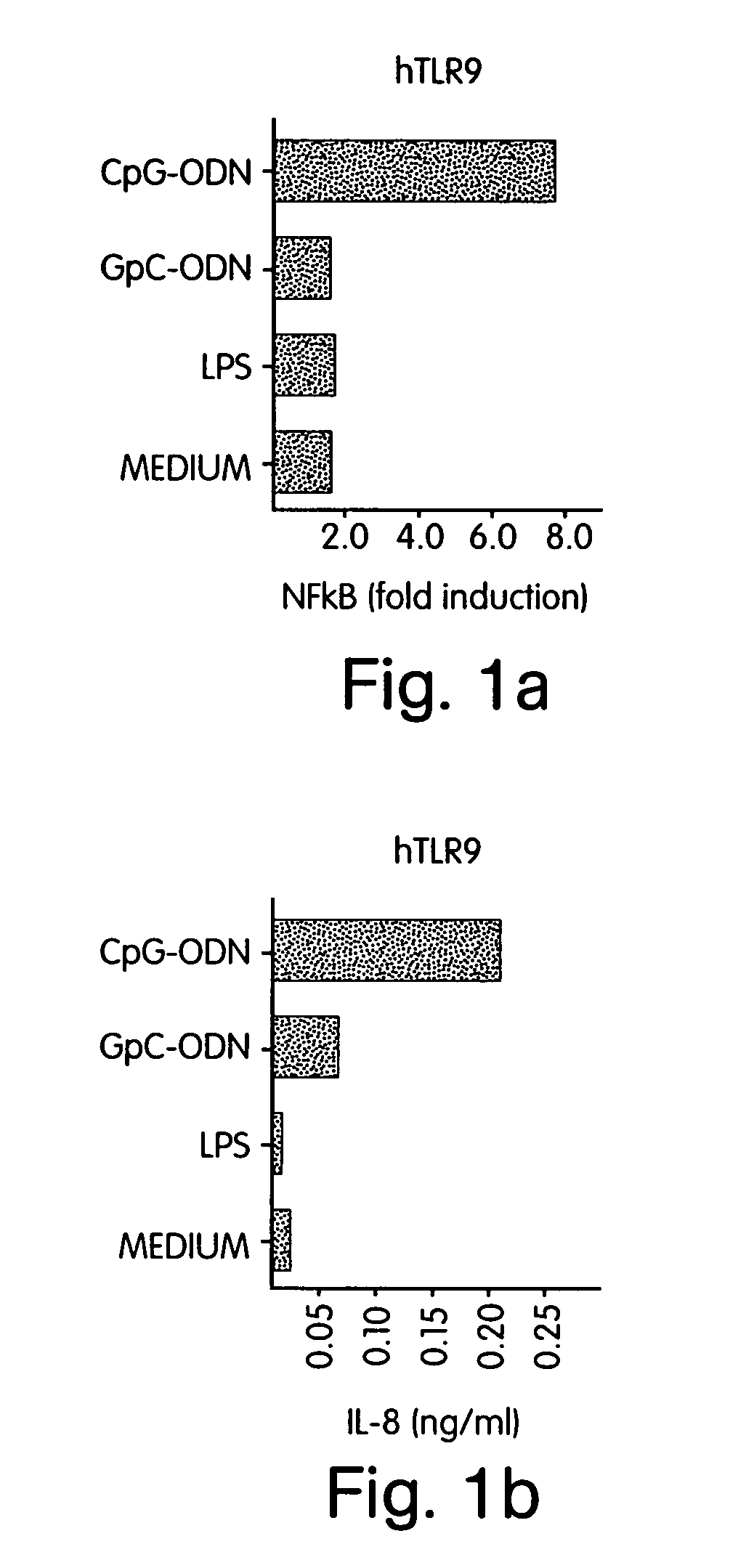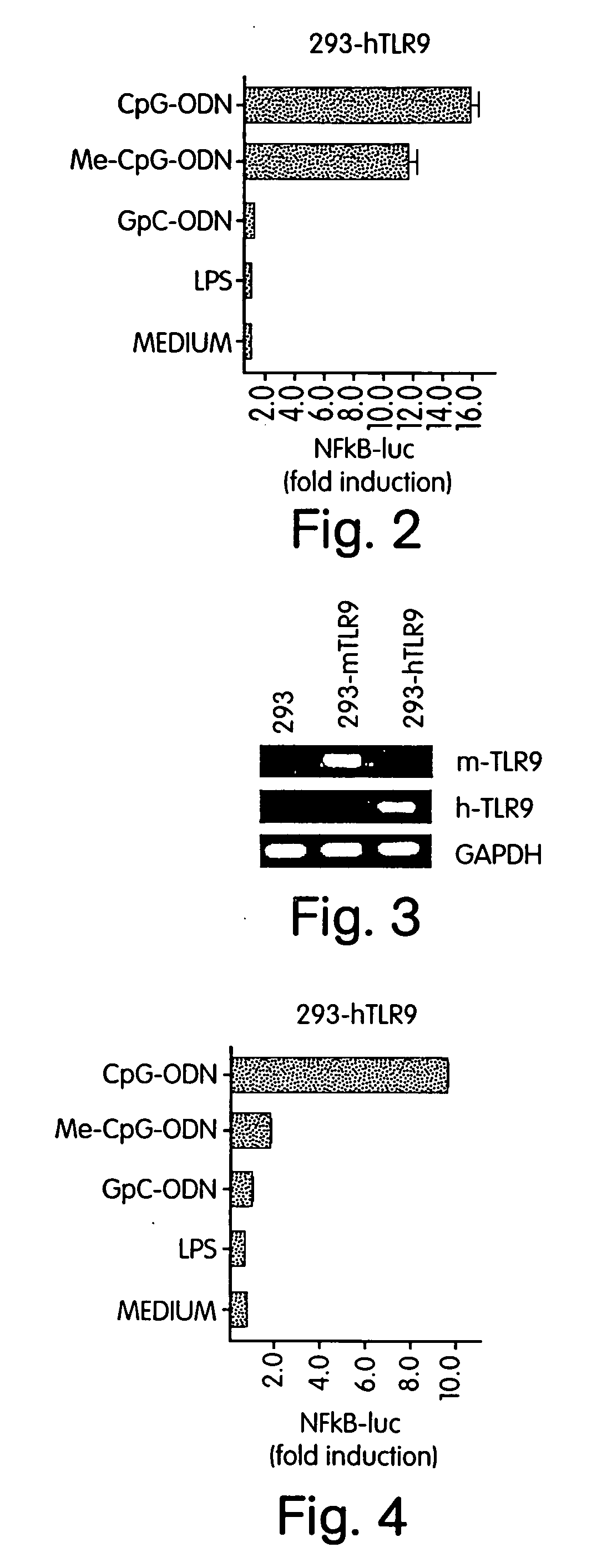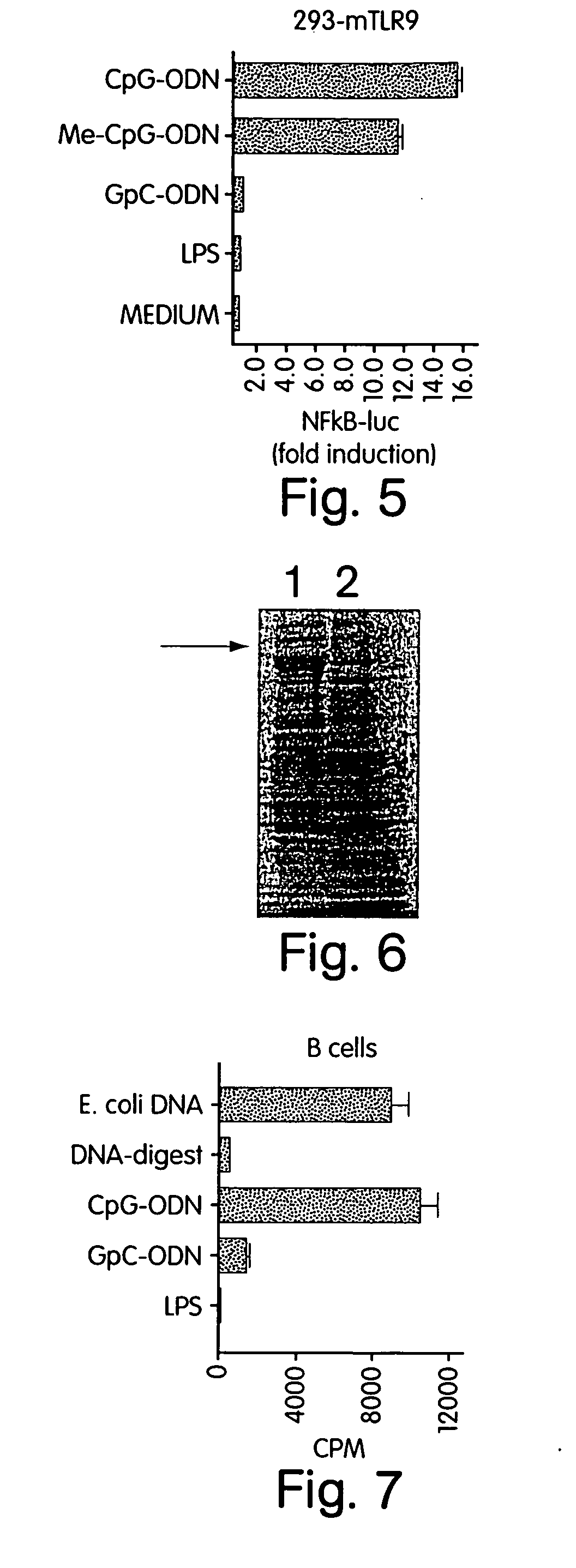Process for high throughput screening of CpG-based immuno-agonist/antagonist
a technology of immuno-adjuvants and screening processes, applied in the direction of immunological disorders, drug compositions, peptides, etc., can solve the problems of limited development of screening for optimal cpg motifs through direct binding analysis, and the previous form of host defense is discovered, so as to increase tlr9 signaling and reduce tlr9 signaling activity
- Summary
- Abstract
- Description
- Claims
- Application Information
AI Technical Summary
Benefits of technology
Problems solved by technology
Method used
Image
Examples
example 1
Method of Cloning the Mouse TLR9
[0332] Alignment of human TLR9 protein sequence with mouse EST database using tfasta yielded 7 hits with mouse EST sequences aa197442, ai451215, aa162495, aw048117, ai463056, aw048548, and aa273731. Two primers were designed that bind to aa197442 EST sequence for use in a RACE-PCR to amplify 5′ and 3′ ends of the mouse TLR9 cDNA. The library used for the RACE PCR was a mouse spleen marathon-ready cDNA commercially available from Clonetech. A 5′ fragment with a length of 1800 bp obtained by this method was cloned into Promega pGEM-T Easy vector. After sequencing of the 5′ end, additional primers were designed for amplification of the complete mouse TLR9 cDNA. The primer for the 5′ end was obtained from the sequence of the 5′ RACE product whereas the primer for the 3′ end was selected from the mouse EST sequence aa273731.
[0333] Three independent PCR reactions were set up using a murine macrophage RAW264.7 (ATCC TIB-71) cDNA as a template, and the resu...
example 2
Reconstitution of TLR9 Signaling in 293 Fibroblasts
[0337] The cloned mouse TLR9 cDNA (see above) and human TLR9 cDNA (gift from B. Beutler, Howard Hughes Medical Institute, Dallas, Tex.) in pT-Adv vector (from Clonetech) were cloned into the expression vector pcDNA3.1 (−) from Invitrogen using the EcoRI site. Utilizing a “gain of function” assay it was possible to reconstitute human TLR9 (hTLR9) and murine TLR9 (mTLR9) signaling in CpG DNA non-responsive human 293 fibroblasts (ATCC, CRL-1573). The expression vectors mentioned above were transfected into 293 fibroblast cells using the calcium phosphate method.
[0338] Since NF-κB activation is central to the IL-1 / TLR signal transduction pathway (Medzhitov R et al., Mol Cell 2:253-258 (1998); Muzio M et al., J Exp Med 187:2097-2101 (1998)), cells were transfected with hTLR9 or co-transfected with hTLR9 and a NF-κB-driven luciferase reporter construct. Human fibroblast 293 cells were transiently transfected with (FIG. 1A) hTLR9 and a s...
example 3
Expression of Soluble Recombinant Human TLR9 in Yeast Cells (Pichia pastoris)
[0346] Human TLR9 cDNA coding for amino acids 1 to 811 was amplified by PCR using the primers 5′-ATAGAATTCAATAATGGGTTTCTGCCGCAGCGCCCT-3′ (SEQ ID NO:194) and 5′-ATATCTAGATCCAGGCAGAGGCGCAGGTC-3′ (SEQ ID NO:195), digested with EcoRI and XbaI, cloned into the yeast expression vector pPICZB (Invitrogen, Groningen, Netherlands) and transfected into yeast cells (Pichia pastoris). Clones were selected with the antibiotic zeozin and protein production of soluble human TLR9 was induced with methanol (see FIG. 6: SDS-PAGE, Coomassie stained, arrow marks hTLR9; lane 1: supernatant of culture induced with methanol; lane 2: supernatant of culture not induced). Thus TLR9 protein can be isolated from transfectants and further utilized for protein studies and vaccination purposes.
PUM
 Login to View More
Login to View More Abstract
Description
Claims
Application Information
 Login to View More
Login to View More - R&D
- Intellectual Property
- Life Sciences
- Materials
- Tech Scout
- Unparalleled Data Quality
- Higher Quality Content
- 60% Fewer Hallucinations
Browse by: Latest US Patents, China's latest patents, Technical Efficacy Thesaurus, Application Domain, Technology Topic, Popular Technical Reports.
© 2025 PatSnap. All rights reserved.Legal|Privacy policy|Modern Slavery Act Transparency Statement|Sitemap|About US| Contact US: help@patsnap.com



